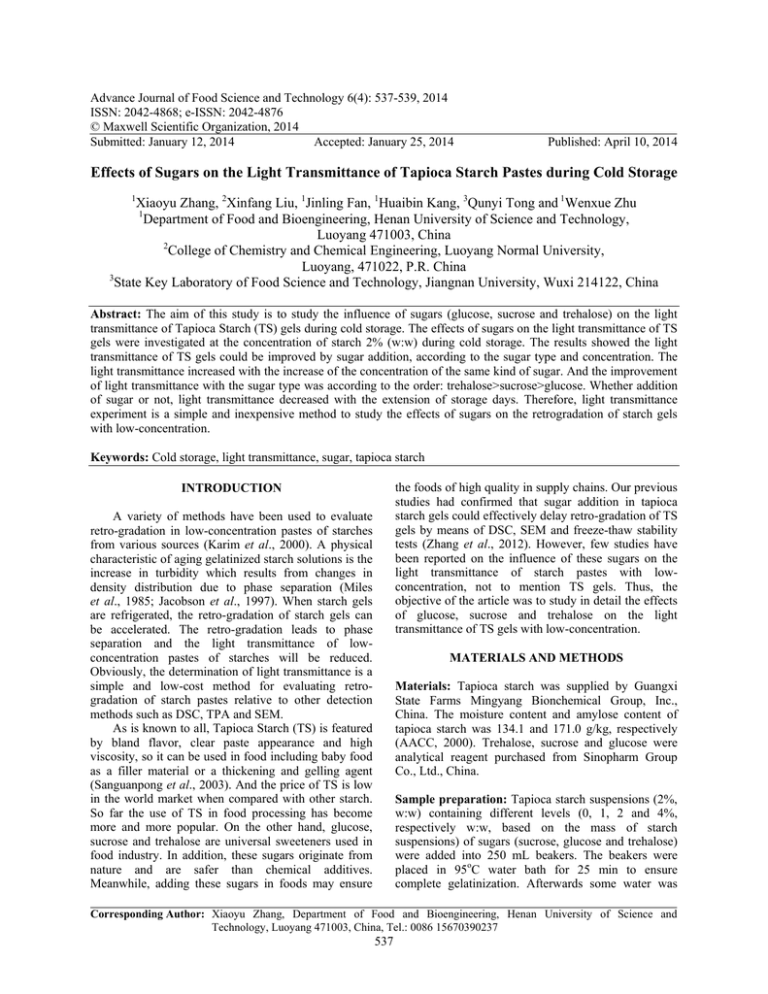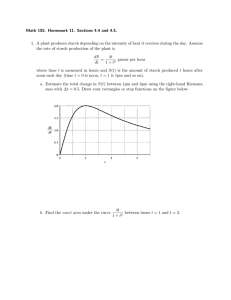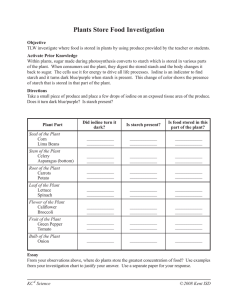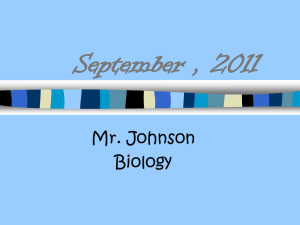Advance Journal of Food Science and Technology 6(4): 537-539, 2014
advertisement

Advance Journal of Food Science and Technology 6(4): 537-539, 2014 ISSN: 2042-4868; e-ISSN: 2042-4876 © Maxwell Scientific Organization, 2014 Submitted: January 12, 2014 Accepted: January 25, 2014 Published: April 10, 2014 Effects of Sugars on the Light Transmittance of Tapioca Starch Pastes during Cold Storage 1 Xiaoyu Zhang, 2Xinfang Liu, 1Jinling Fan, 1Huaibin Kang, 3Qunyi Tong and 1Wenxue Zhu 1 Department of Food and Bioengineering, Henan University of Science and Technology, Luoyang 471003, China 2 College of Chemistry and Chemical Engineering, Luoyang Normal University, Luoyang, 471022, P.R. China 3 State Key Laboratory of Food Science and Technology, Jiangnan University, Wuxi 214122, China Abstract: The aim of this study is to study the influence of sugars (glucose, sucrose and trehalose) on the light transmittance of Tapioca Starch (TS) gels during cold storage. The effects of sugars on the light transmittance of TS gels were investigated at the concentration of starch 2% (w:w) during cold storage. The results showed the light transmittance of TS gels could be improved by sugar addition, according to the sugar type and concentration. The light transmittance increased with the increase of the concentration of the same kind of sugar. And the improvement of light transmittance with the sugar type was according to the order: trehalose>sucrose>glucose. Whether addition of sugar or not, light transmittance decreased with the extension of storage days. Therefore, light transmittance experiment is a simple and inexpensive method to study the effects of sugars on the retrogradation of starch gels with low-concentration. Keywords: Cold storage, light transmittance, sugar, tapioca starch the foods of high quality in supply chains. Our previous studies had confirmed that sugar addition in tapioca starch gels could effectively delay retro-gradation of TS gels by means of DSC, SEM and freeze-thaw stability tests (Zhang et al., 2012). However, few studies have been reported on the influence of these sugars on the light transmittance of starch pastes with lowconcentration, not to mention TS gels. Thus, the objective of the article was to study in detail the effects of glucose, sucrose and trehalose on the light transmittance of TS gels with low-concentration. INTRODUCTION A variety of methods have been used to evaluate retro-gradation in low-concentration pastes of starches from various sources (Karim et al., 2000). A physical characteristic of aging gelatinized starch solutions is the increase in turbidity which results from changes in density distribution due to phase separation (Miles et al., 1985; Jacobson et al., 1997). When starch gels are refrigerated, the retro-gradation of starch gels can be accelerated. The retro-gradation leads to phase separation and the light transmittance of lowconcentration pastes of starches will be reduced. Obviously, the determination of light transmittance is a simple and low-cost method for evaluating retrogradation of starch pastes relative to other detection methods such as DSC, TPA and SEM. As is known to all, Tapioca Starch (TS) is featured by bland flavor, clear paste appearance and high viscosity, so it can be used in food including baby food as a filler material or a thickening and gelling agent (Sanguanpong et al., 2003). And the price of TS is low in the world market when compared with other starch. So far the use of TS in food processing has become more and more popular. On the other hand, glucose, sucrose and trehalose are universal sweeteners used in food industry. In addition, these sugars originate from nature and are safer than chemical additives. Meanwhile, adding these sugars in foods may ensure MATERIALS AND METHODS Materials: Tapioca starch was supplied by Guangxi State Farms Mingyang Bionchemical Group, Inc., China. The moisture content and amylose content of tapioca starch was 134.1 and 171.0 g/kg, respectively (AACC, 2000). Trehalose, sucrose and glucose were analytical reagent purchased from Sinopharm Group Co., Ltd., China. Sample preparation: Tapioca starch suspensions (2%, w:w) containing different levels (0, 1, 2 and 4%, respectively w:w, based on the mass of starch suspensions) of sugars (sucrose, glucose and trehalose) were added into 250 mL beakers. The beakers were placed in 95oC water bath for 25 min to ensure complete gelatinization. Afterwards some water was Corresponding Author: Xiaoyu Zhang, Department of Food and Bioengineering, Henan University of Science and Technology, Luoyang 471003, China, Tel.: 0086 15670390237 537 Adv. J. Food Sci. Technol., 6(4): 537-539, 2014 added to supplement the loss of water evaporation. The beakers were then placed briefly under slight vacuum to remove air bubbles. The pastes were transferred to volumetric flask and cooled in 25oC water bath for 1 h. TS TS+Trehalose (2:1, w:w ) TS+Trehalose (1:1, w:w) TS+Trehalose (1:2, w:w) Transmittance 26 Determination of light transmittance: Initial light transmittance was determined by absorbance at 640 nm (Miles et al., 1985) using a UV 2100/visible spectrophotometer equipped with a programmable cell changer. The remaining cooled pastes were stored in a refrigerator at 4°C. After 1, 3, 5, 7, 10, 14, 21, 28 days, respectively at 4°C, the pastes in flasks were put in 25°C water bath for 1h and were agitated briefly by a wrist-arm shaker before the determination of the light transmittance. 24 22 20 18 16 14 12 10 0 5 25 15 20 10 Cold-storage period (day) 30 Fig. 1: Transmission of TS (2%, w:w) gel in the absence or presence of trehalose at 4°C Statistical analysis: The results of the light transmittance tests were reported as mean±S.D. for three replications. The difference between means was determined using the Duncan’s new multiple range test. All data were statistical analyzed using SPSS software (version 12.0 for Windows; SPSS Inc., Chicago, IL, USA). TS TS+Sucrose (2:1, w:w ) TS+Sucrose (1:1, w:w ) TS+Sucrose (1:2, w:w ) Transmittance 26 RESULTS AND DISCUSSION To discuss the effects of sugars on the light transmittance of 2% tapioca starch pastes, transmission of TS (2%, w:w) gel in the absence or presence of sucrose, glucose or trehalose at 4°C were determined and presented in Fig. 1 to 3. The transmission of TS (2%, w:w) gels decreased along with cold preservation time. From 0 to 7 days, the downward trend was obvious. And after that the transmission didn’t drop obviously and the trend sloped gently. The changes indicated the retro-gradation of starch gels was fast in the early stage of refrigeration and then reached saturation. The pastes containing different amounts of sugars (sucrose, glucose or trehalose) had the same changing tendency as the pastes with no sugar. But comparing with the pure starch pastes, the samples in presence of sugars sloped gently and the downward trend became less obvious with the prolongation of the storage time. That is to say, the addition of sugars could improve the transmission obviously and it increased with the addition amounts of sugars. For example, as for the pastes containing different amounts of trehalose (starch: trehalose = 2:1, 1:1, 1:2, w:w), the transmission was 15.7, 18.4 and 20.1 respectively, while the pure paste is 10.4 after 28 days. Because transmission is positively related to the retro-gradation of TS gels, the downtrends in Fig. 1 to 3 showed that sugars could effectively retard the retro-gradation of low concentration starch pastes. In case of different kinds of sugars, the improvement of transmission was in the order: trehalose>sucrose>glucose (Fig. 1 to 3). These facts showed that of these sugars, trehalose performed best in 24 22 20 18 16 14 12 10 0 5 25 15 20 10 Cold-storage period (day) 30 Fig. 2: Transmission of TS (2%, w:w) gel in the absence or presence of sucrose at 4°C TS TS+Glucose (2:1, w:w) TS+Glucose (1:1, w:w) TS+Glucose (1:2, w:w) Transmittance 26 24 22 20 18 16 14 12 10 0 5 25 15 20 10 Cold-storage period (day) 30 Fig. 3: Transmission of TS (2%, w:w) gel in the absence or presence of glucose at 4°C curbing the retro-gradation of TS gels, which were consistent with our previous results (Zhang et al., 2012). The possible reason for the improvement of the retro-gradation by sugars was that starch pastes containing sugars formed strong interaction between sugars and starch molecular via intermolecular hydrogen-bonding, which prevented starch chain 538 Adv. J. Food Sci. Technol., 6(4): 537-539, 2014 REFERENCES re-associating and then reduced the size of starch chain. More specifically, sugar molecules interact with starch molecular chains to stabilize the amorphous and entangled matrix of gelatinized starch (Spies and Hoseney, 1982; Slade and Levine, 1987). The direct result of the presence of relatively small size of starch chain was that light was allowed to pass through the starch gels instead of being refracted and/or scattered. AACC (American Association of Cereal Chemists), 2000. Approved Methods of the AACC. 10th Edn., Including the 2001 Supplement, AACC, St. Paul. Jacobson, M.R., M. Obanni and J.N. Bemiller, 1997. Retrogradation of starches from different botanical sources 1. Cereal Chem., 74(5): 511-518. Karim, A.A., M.H. Norziah and C.C. Seow, 2000. Methods for the study of starch retrogradation. Food Chem., 71(1): 9-36. Miles, M.J., V.J. Morris, P.D. Orford and S.G. Ring, 1985. The roles of amylose and amylopectin in the gelation and retrogradation of starch. Carbohyd. Res., 135: 271-278. Sanguanpong, V., S. Chotineeranat, K. Piyachomkwan, C.G. Oates, P. Chinachoti and K. Sriroth, 2003. Hydration and physicochemical properties of small-particle cassava starch. J. Sci. Food. Agr., 83: 123-132. Slade, L. and H. Levine, 1987. Recent Advances in Starch Retrogradation. In: Stivala, S.S., V. Crescenzi and I.C.M. Dea (Eds.), Industrial Polysaccharides: The Impact of Biotechnology and Advanced Methodologies. Gordon and Breach Science, New York. Spies, R.D. and R.C. Hoseney, 1982. Effect of sugars on starch gelatinization. Cereal Chem., 59: 128-131. Zhang, X.Y., Q.Y. Tong and F. Ren, 2012. Influence of glucose, sucrose and trehalose on the freeze-thaw stability of tapioca starch gels. Adv. J. Food Sci. Technol., 4: 225-230. CONCLUSION This study shows that sugar addition could improve the light transmission of TS (2%, w:w) gels. With the increase of sugar addition and cold storage time, the improvements appeared more obvious. In case of different kinds of sugars, the improvement of transmission was in the order: trehalose>sucrose >glucose. The results further proved that sugars could retard the starch retro-gradation and trehalose was a good candidate for curbing the retro-gradation of TS gels. And light transmittance provides a simple and inexpensive method for studying the effects of sugars on the retro-gradation of starch gels with lowconcentration. ACKNOWLEDGMENT The authors gratefully acknowledge the financial support from the Doctor Research Program of Henan University of Science and Technology (09001744). 539








